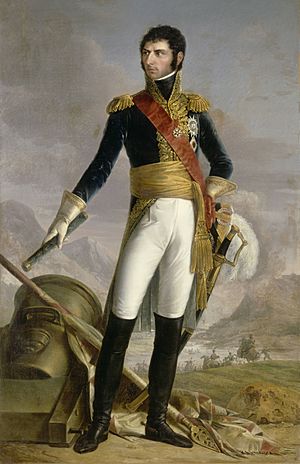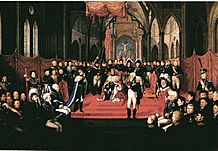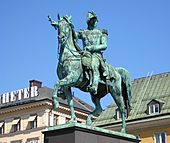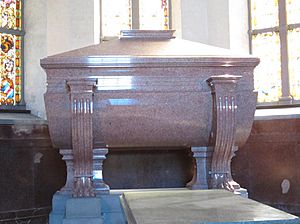Charles XIV John facts for kids
Quick facts for kids Charles XIV John |
|||||
|---|---|---|---|---|---|
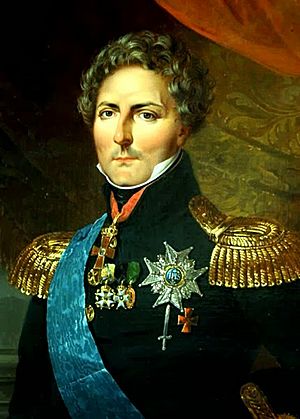
Portrait of Charles John c. 1830
|
|||||
| King of Sweden and Norway | |||||
| Reign | 5 February 1818 – 8 March 1844 | ||||
| Coronations |
|
||||
| Predecessor | Charles XIII & II | ||||
| Successor | Oscar I | ||||
| Prince of Pontecorvo | |||||
| Reign | 5 June 1806 – 21 August 1810 | ||||
| Successor | Lucien Murat | ||||
| Minister of War of the French Republic | |||||
| In office 2 July 1799 – 14 September 1799 |
|||||
| Preceded by | Louis Marie de Milet de Mureau | ||||
| Succeeded by | Edmond Louis Alexis Dubois-Crancé | ||||
| Born | Jean Bernadotte, later Jean-Baptiste Bernadotte, later Jean-Baptiste Jules Bernadotte 26 January 1763 Pau, France |
||||
| Died | 8 March 1844 (aged 81) Stockholm, Sweden |
||||
| Burial | 26 April 1844 Riddarholm Church |
||||
| Spouse |
Désirée Clary
(m. 1798) |
||||
| Issue | Oscar I of Sweden | ||||
|
|||||
| House | Bernadotte | ||||
| Father | Henri Bernadotte | ||||
| Mother | Jeanne de Saint-Jean | ||||
| Religion | Lutheran prev. Roman Catholic |
||||
| Signature |  |
||||
| Military career | |||||
| Allegiance |
|
||||
| Years of service | 1780–1844 | ||||
| Rank | Marshal of the Empire and Generalissimo of the Swedish Armed Forces | ||||
| Commands held |
|
||||
| Battles/wars | |||||
| Awards |
|
||||
| Other work |
|
||||
Charles XIV John (born Jean Bernadotte; 26 January 1763 – 8 March 1844) was the King of Sweden and Norway from 1818 until his death. Before becoming king, he was a famous Marshal of France during the Napoleonic Wars. In Norway, he is sometimes called Charles III John. He was the very first king from the Bernadotte family, which still rules Sweden today.
Born in Pau, France, Bernadotte joined the French army in 1780. During the French Revolution, he quickly rose through the ranks because of his military skills. He became a general by 1794. Even though his relationship with Napoleon was sometimes difficult, Napoleon made him a Marshal of the Empire. Bernadotte played a big part in the French victory at the Battle of Austerlitz and was made Prince of Pontecorvo. He was also related to Napoleon's family through his marriage to Désirée Clary.
In 1810, something unexpected happened: Bernadotte was chosen to be the next king of Sweden. The Swedish king, Charles XIII of Sweden, had no children. Bernadotte became the heir-presumptive (Crown Prince) and took the name Charles John. He quickly became the de facto (actual) leader of Sweden. In 1813, after French troops invaded Swedish Pomerania, Charles John helped create the Sixth Coalition. This was an alliance against Napoleon, bringing together countries like Russia and Britain. He helped plan the Allied strategy and led the Allied Army of the North, which played a key role in defeating Napoleon at the Battle of Leipzig.
After the war, Charles John forced Denmark to give Norway to Sweden. This led to a short war in 1814, which Sweden won. Norway then joined a union with Sweden that lasted for nearly a century. This war was the last time Sweden was directly involved in a major conflict.
When Charles XIII died in 1818, Charles John became king. He ruled during a time of peace and growth for Sweden and Norway until his death in 1844.
Contents
Early Life and Military Career
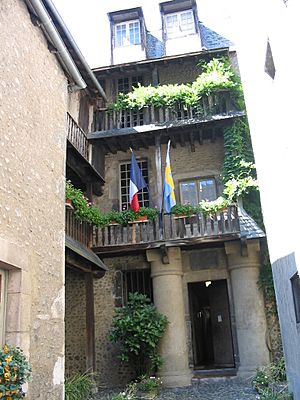
Jean-Baptiste Jules Bernadotte was born on 26 January 1763 in Pau, a city in southwestern France. His father was a lawyer. Jean-Baptiste was the youngest of five children. When he was 14, he started working for a local lawyer. But after his father died when he was 17, he decided not to follow that path.
Instead, Bernadotte joined the army as a private soldier in 1780. He served in places like Corsica and other French cities. By 1785, he became a sergeant and was known for his smart appearance. In 1790, he reached the highest rank for a non-commissioned officer.
Rising Through the Ranks During the French Revolution
When the French Revolution began, Bernadotte's military skills quickly earned him promotions. He was known for his brave attacks and his ability to inspire his soldiers. For example, once his troops were retreating, he dramatically took off his general's badges and threw them on the ground, saying he wouldn't be their leader if they ran away. His soldiers picked up his badges, gave them back to him, and then fought back!
By 1794, he was promoted to brigadier general. He fought bravely in battles like Fleurus, where his decisive attack helped the French win. He continued to play important roles in battles in Germany, often leading the charge or protecting the army during retreats. At the Battle of Theiningen in 1796, his small group of soldiers fought off a much larger Austrian army, helping the French retreat safely.
He later joined Napoleon Bonaparte's army in Italy. Bernadotte showed great skill in battles like the crossing of the Tagliamento river and the capture of Gradisca fortress.
Marshal of the French Empire
When the First French Empire was created, Napoleon made Bernadotte one of the eighteen Marshals of the Empire. From 1804 to 1805, he was the governor of Hanover, a German region France had taken over. He gained a reputation for being fair and honest. People liked his rule, and even though he had to collect money for Napoleon, Hanover's economy did well. He also supported Gottingen University and befriended many scholars.
In 1805, Bernadotte led a large part of Napoleon's army. He helped defeat the Austrians and captured Salzburg. At the Battle of Austerlitz in December 1805, he helped defeat the Allied forces. As a reward, he was made the first Prince of Ponte Corvo, a small area in Italy.
Challenges and Victories
During the 1806 campaign against Prussia, Napoleon was unhappy that Bernadotte's army corps did not join the main battles of Jena and Auerstädt. However, Bernadotte was following his orders to march to a different location. He later crushed the Prussian Reserve Army at Halle and helped chase down and defeat Prussian General Blücher at Lübeck.
When the French took Lübeck, there was a lot of looting. Bernadotte worked hard to stop his soldiers from stealing. He was even given horses by the city leaders as a thank you. He also treated 1600 Swedish prisoners very kindly, allowing them to return home. These Swedes were very impressed by Bernadotte's fairness, which would later be important for his future.
Bernadotte was known for his honesty. Unlike some other marshals, he didn't take things from conquered areas. He often used his own money to buy food for his troops and reward brave soldiers. He was strict about stopping looting and would even personally intervene to stop it.
In 1807, he became governor of the Hanseatic cities (important trading cities in northern Germany). He was well-liked there too. Napoleon even considered making Bernadotte the king of Spain at one point, but Bernadotte refused.
At the Battle of Wagram in 1809, Bernadotte's Saxon troops fought bravely but were badly damaged. He later resigned after a disagreement with Napoleon about how the battle was described.
After this, Bernadotte was put in charge of defending Antwerp from a British invasion. He quickly organized and trained a mixed army, turning a chaotic group into a strong defense force. The British eventually gave up their attack because Antwerp was too well-defended.
Becoming Crown Prince of Sweden
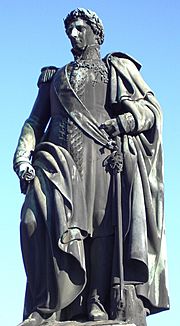
In 1810, Bernadotte was about to start a new job as governor of Rome when he was surprisingly chosen to be the next king of Sweden. The Swedish king, Charles XIII, was old and sick and had no children. His adopted heir had recently died.
Sweden needed a new leader, and they wanted someone who could get Napoleon's support. A Swedish courtier, Baron Karl Otto Mörner, on his own, offered the Swedish crown to Bernadotte. Napoleon was surprised but eventually supported Bernadotte's choice.
On 21 August 1810, Bernadotte was officially elected as the new Crown Prince by the Swedish Parliament. He was also made the supreme commander of the Swedish Armed Forces. Several things helped Bernadotte get elected:
- His (assumed) close ties to Napoleon, which Sweden hoped would provide military help to get Finland back.
- The Swedish army wanted a soldier as their leader, especially with possible conflict with Russia.
- Bernadotte was personally popular because of how kindly he treated Swedish prisoners in Lübeck and his good reputation as governor of the Hanseatic Cities.
- He was willing to convert to Lutheranism, which was required for the Swedish monarch.
Before letting Bernadotte go, Napoleon asked him to promise never to fight against France. Bernadotte refused, saying his duty to Sweden came first. Napoleon then let him go without any conditions. Many Swedes hoped he would help them get Finland back from Russia.
Crown Prince and Regent of Sweden
On 2 November 1810, Bernadotte arrived in Stockholm. He was adopted by King Charles XIII and took the name "Charles John." He also changed his religion from Catholicism to Lutheranism.
The new Crown Prince quickly became the most popular and powerful person in Sweden. The old king was often ill, so Charles John took charge of the government, especially foreign policy. One of his first goals was to fix Sweden's struggling economy. He used his own money, which he had earned honestly as a French Marshal, to pay off much of the country's debt and help stabilize the economy.
Charles John decided that instead of trying to get Finland back from Russia (which would be very difficult and lead to more wars), he would try to unite the Scandinavian Peninsula by taking Norway from Denmark. He believed a united peninsula would be easier to defend and bring lasting peace.
In January 1812, French troops suddenly invaded Swedish Pomerania. This made Charles John very angry, as it was a clear violation of international law. He believed Napoleon did this to insult him. Because of this invasion, Charles John's friendly relationship with Napoleon ended. Sweden declared neutrality and began talking with the UK and Russia.
Leading the Fight Against Napoleon
In 1812, Charles John made an alliance with Russia, Sweden's traditional enemy. He also made peace with the United Kingdom. This led to the Treaty of Örebro on 18 July 1812, which formed the Sixth Coalition against France. Sweden promised to send an army to fight France, and in return, Russia and the UK would support Sweden in taking Norway from Denmark.
Charles John worked hard to get more allies. He even made a treaty with the Spanish against his own brother-in-law, who was then King of Spain. He also encouraged the King of Prussia to join the Coalition.
After some defeats for the Allies in 1813, it was Charles John who inspired them to keep fighting. At the conference of Trachenberg, he helped create the Trachenberg Plan, which was the main strategy for the rest of the war.
As the Commander-in-Chief of the Northern Army, Charles John successfully defended Berlin and won battles against French marshals Oudinot and Ney. His army joined the Battle of Leipzig on 19 October. During this battle, many Saxon soldiers, who remembered Bernadotte's kind treatment, switched sides and joined his army. Charles John's fresh troops helped deliver the final blow to Napoleon's army, and he was one of the first Allied leaders to enter Leipzig.
After the Battle of Leipzig, Charles John focused on getting Norway. He quickly defeated the Danes, leading to the Treaty of Kiel, which gave Norway to Sweden.
However, the Norwegians didn't want to be ruled by Sweden. They declared independence, created their own constitution, and chose a Danish prince as their king. Charles John then led the Swedish army to quickly defeat Norway. This was Sweden's last war. Charles John could have forced harsh terms on Norway, but he wisely accepted their constitution and their right to govern themselves. This led to Norway joining a personal union with Sweden later that year, where they shared a king but kept their own laws.
During the Allied invasion of France in 1814, some leaders, like the Russian Tsar Alexander I, wanted Charles John to become the new king of France instead of Napoleon. But the British and Austrians disagreed, and they decided to bring back the old French royal family, the House of Bourbon.
King of Sweden and Norway
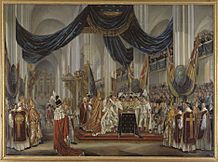
Charles John had been the actual leader of Sweden since 1810. When King Charles XIII died on 5 February 1818, Charles John officially became king of both Sweden and Norway. He was popular in both countries at first.
As king, Charles John focused on keeping peace and making the economy stronger. He kept his kingdoms out of wars from 1814 until his death. This was a big change for Sweden, which had been involved in many wars for centuries. He was especially careful to stay neutral in conflicts between big powers like the UK and Russia. This policy of neutrality is seen as the beginning of Sweden's famous neutrality.
During his 26-year reign, Sweden's population grew, the national debt was paid off, and the economy improved. Education, farming, trade, and manufacturing all did well. He also improved roads and other ways of communication.
However, Charles John became more conservative as he got older. His strict ways, especially censoring the press, made him unpopular after 1823. But his family's rule was safe because Swedes and Norwegians were proud of their king's good reputation in Europe.
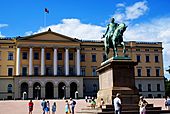
In Norway, he faced challenges because the Norwegian constitution gave their parliament, the Storting, a lot of power. Charles John wanted more power, including an absolute veto (the power to completely block laws), but the Storting refused. His difficult relationship with Norway was also seen when the Storting was slow to give money for a new Royal Palace in Oslo. The palace was not finished until 1849, after Charles John's death. The main street in Oslo, Slottsgaten, was later named Karl Johans gate after him.
His popularity dropped for a while in the 1830s, leading to some protests. But Charles John survived these challenges. His 25th anniversary as king was celebrated with great enthusiasm in 1843. He ruled until his death on 8 March 1844.
Death and Legacy
On his 81st birthday, 26 January 1844, Charles John was found unconscious after having a stroke. He woke up but never fully recovered and died on 8 March.
He was buried in Riddarholm Church in Stockholm. His only son, Oscar I, became the next king.
Charles John is remembered for:
- The main street of Oslo, Karl Johans gate, named after him in 1852.
- The main base for the Royal Norwegian Navy, Karljohansvern, named after him in 1854.
- The Karlsborg Fortress in Sweden, also named in his honor.
- The Caserne Bernadotte, a French military building in Pau, named after him in 1875.
- A large bronze statue of him on horseback outside the Royal Palace in Oslo, unveiled in 1875.
Honours
- French Empire: Knight Grand Eagle of the Legion of Honour, 2 February 1805
- Kingdom of Italy: Knight Grand Cross of the Order of the Iron Crown
- Sweden:
- Knight of the Order of the Seraphim, 21 August 1810
- Knight Grand Cross of the Order of the Sword, 1st Class, 21 August 1810
- Commander Grand Cross of the Order of Vasa, 28 January 1813
- Commander Grand Cross of the Order of the Polar Star, 21 August 1810
- Knight of the Order of Charles XIII, 21 August 1810
He became the leader of all Swedish orders of knighthood when he became king.
Foreign Honours
- Kingdom of Bavaria: Knight of the Order of St. Hubert, 1805
- Kingdom of Prussia:
- Knight of the Order of the Black Eagle, 7 April 1805
- Knight Grand Cross of the Order of the Red Eagle, 7 April 1805
- Grand Cross of the Iron Cross, 1813
- Denmark: Knight of the Order of the Elephant, 15 October 1808
- Kingdom of Saxony:
- Knight Grand Cross of the Military Order of St. Henry, 1809
- Knight of the Order of the Rue Crown, 1832
- Russia:
- Knight of the Order of St. Andrew, 30 August 1812
- Knight of the Order of St. Alexander Nevsky, 30 August 1812
- Knight of the Order of St. Anna, 1st Class
- Knight of the Order of St. George, 1st Class, 30 August 1813
- Austrian Empire: Knight Grand Cross of the Military Order of Maria Theresa, 1813
- Spain: Knight of the Order of the Golden Fleece, 2 September 1822
- Baden:
- Knight Grand Cross of the House Order of Fidelity, 1830
- Knight Grand Cross of the Order of the Zähringer Lion, 1830
- Kingdom of Portugal: Knight Grand Cross of the Order of the Tower and Sword
- United Kingdom of Great Britain and Ireland: Knight of the Order of St. Patrick
Arms and Monogram
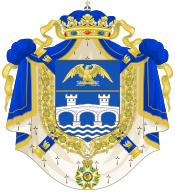 Prince of Pontecorvo |
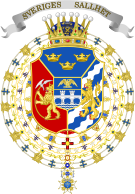 Coat of arms of Crown Prince Charles John according to the armorial of Knights of the order of the Seraphim |
 Coat of arms of King Charles XIV John of Sweden and Norway |
Fictional Stories About Charles John
A play from 1833 called Le Camarade de lit (The Bedfellow) told a funny story about Bernadotte as King of Sweden. An old soldier claimed that when Bernadotte was young, he got a tattoo of a rebellious message like "Death to kings." In the play, the tattoo is finally shown to say "Long live the Republic" and shows a Phrygian cap (a symbol of freedom). This play was so popular that many people believed the story about the tattoo, even though it's not true.
The relationships of his wife, Désirée Clary, with Napoleon and Bernadotte were the subject of the novel Désirée by Annemarie Selinko. This novel was also made into a movie in 1954, starring Marlon Brando as Napoleon and Jean Simmons as Désirée.
Bernadotte is also an important character in the historical novel A Queen's Fortune by Allison Pataki. This book tells the life story of his wife and Queen, Désirée Clary.
See also
 In Spanish: Carlos XIV Juan de Suecia para niños
In Spanish: Carlos XIV Juan de Suecia para niños
- Swedish–Norwegian War (1814)
- Union between Sweden and Norway
- Napoleonic Wars
- War of the Sixth Coalition
Images for kids
-
Bust of a young Bernadotte at the Bernadotte Museum in Pau, France


